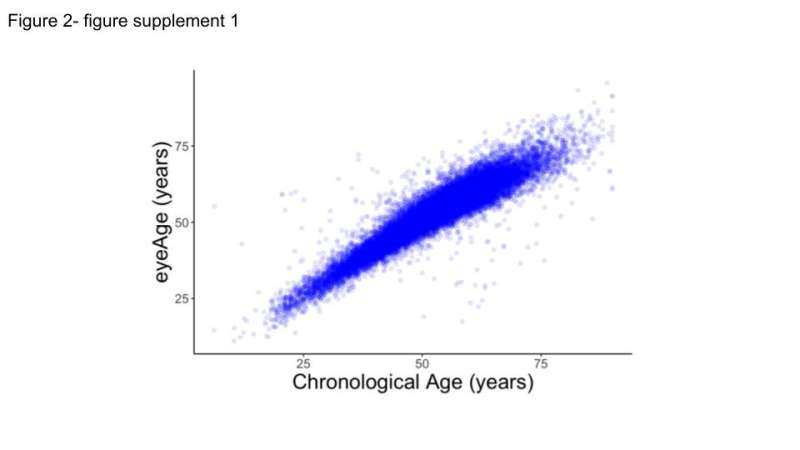
Buck Institute professor Pankaj Kapahi thinks the eye is a window to aging. His lab, in collaboration with Google Health and Zuckerberg San Francisco General Hospital, has shown how imaging of the fundus, the blood vessel-rich tissue in the retina, can be used to track human aging, in a way that is noninvasive, less expensive and more accurate than other aging clocks that are currently available. Publishing in eLife, researchers also did a genome-wide association study (GWAS) to establish the genetic basis for such a clock, which they call eyeAge.
“This type of imaging could be really valuable in tracking the efficacy of interventions aimed at slowing the aging process,” says Kapahi, a senior co-author of the study. “The results suggest that potentially, in less than one year we should be able to determine the trajectory of aging with 71% accuracy by noting discernable changes in the eyes of those being treated, providing an actionable evaluation of gero-protective therapeutics.” Kapahi noted that retinal scans are likely more reliable because changes in the eye are less susceptible to day-to-day fluctuations than biomarkers from the blood, which are more dynamic and can be influenced by something as simple as eating a meal or a current infection.
A growing body of evidence suggests that the microvasculature in the retina might be a reliable indicator of the overall health of the body’s circulatory system and the brain. Changes in the eye accompany aging and many age-related diseases including age-related macular degeneration (AMD), diabetic retinopathy, and Parkinson’s and Alzheimer’s disease. Ophthalmologists can often detect early symptoms of AIDS, chronic high blood pressure and tumors in the eyes, a utility that is not surprising given that any subtle changes in the vascular system first appear in the smallest blood vessels, and capillaries in the retina are among the smallest in the body.
But subtle changes in these small blood vessels often go undetected by even the most sophisticated instruments, necessitating the use of deep learning, an effort spearheaded by Google Research. Researchers from Google and elsewhere have developed models to predict diabetic retinopathy from retinal images and have gone on to use retinal images to identify at least 39 eye diseases including glaucoma, diabetic retinopathy, and AMD, as well as non-eye diseases such as chronic kidney disease and cardiovascular disease.
Google researchers trained and tuned the model for eyeAge using their well-studied EyePACS data set which involves more than 100,000 patients and applied it to patients from the UK Biobank, which involved more than 64,000 patients.
“Our study emphasizes the value of longitudinal data for analyzing accurate aging trajectories. Through EyePACS longitudinal dataset involving multiple scans from individual people over time our results show a more accurate positive prediction ratio for two consecutive visits of individual rather than random, time-matched individuals,” says Sara Ahadi, co-corresponding author and a former Fellow at Google Research who is now Senior Computational Biologist at Alkahest.
Noting that eyeAge is independent from phenotypic age (a well-established aging clock based on blood markers), Ahadi adds, “We are looking at aging through a different lens and bringing more information to the table. We hope eyeAge will be utilized along with other clocks to make tracking aging more robust, powerful and comprehensive.”
The GWAS was done at the Buck Institute utilizing biological samples available from the UK Biobank. Kenneth Wilson, a postdoc at the Buck Institute, validated some of the genes that were highlighted in the analysis, building on previous Buck research that uncovered a connection between diet, eye health and lifespan in Drosophila. Wilson identified nearly 30 genes from patient samples that are associated with visual decline, diabetes, hearing loss, Alzheimer’s disease, cardiovascular disease and stroke. One of the genes, ALKAL2, has been previously shown to extend lifespan in Drosophila (via the fly homolog ALK). When Wilson knocked down the gene in the flies, it improved their vision later in life and extended their lifespan.
Kapahi says results from the research are ripe for more study. “It would be really informative to understand how these genes, which are already linked to other age-related diseases, are affecting the changes we are seeing in the eye,” he says. “This is human data that provides targets for potential treatments for age-related diseases. The fact that we might be able to track their efficacy in such a low cost, non-invasive way is a huge plus.”
More information:
Sara Ahadi et al, Longitudinal fundus imaging and its genome-wide association analysis provide evidence for a human retinal aging clock, eLife (2023). DOI: 10.7554/eLife.82364
Journal information:
eLife
Source: Read Full Article